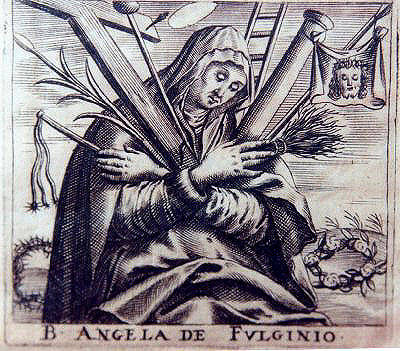As a graduate student, I was first drawn to Angela of Foligno (c. 1248-1309) because of her intensity.
Here was a woman who, in a moment of devotion and penitence, stripped herself naked before the crucifix and offered herself to Christ in chastity and poverty. She experienced an extended vision during Easter Triduum, where she was transported to the sepulcher with Christ; there she kissed his chest and found him dead, but then kissing his mouth smelled “extraordinary fragrances” emanating from his corpse. She went to the hospital “to find Christ” among the lepers there and drank from the water she used to wash leprous sores, noting that it tasted like sweet communion wine. At the basilica in Assisi, she became so enraptured in a vision at a window depicting Francis in the arms of Christ, that she fell to the ground, screaming unintelligibly, and was asked to leave and not return, though St. Francis himself continued to visit her in visions and dreams.
St. Angela (she was canonized by Pope Francis in 2013, centuries after she had been beatified) is identified by the great historian of mysticism Bernard McGinn as among the most important Franciscan mystics and one of four medieval female evangelists. Thomas Merton dubbed her “one of the wild mystics.” Angela’s mystical ascent is not something isolated to her mind in contemplation; she is enraptured body and soul. She tastes, smells, touches, sees and hears Christ. God is not somewhere far away that we have to reach with our minds, but, as Angela describes, Christ is even here touching her skin, as she feels the warmth of his embrace drawing her to himself with the very arms with which he was crucified.
For Angela and other mystics of the side wound, Christ not only provides us a moment for rebirth in the waters of baptism flowing from his side; he also offers us a place to nestle and retreat.
As a student, I failed to recognize how embodied our quest for spiritual union is. Angela knew centuries ago that our love of God is not a detached flight of the spirit; our bodies are essential to this work not because they hold our minds, but because we serve and worship an embodied God, one who entered time and space and became human among us. Angela loved Christ with her body, and likely with a fervor that makes many of us uncomfortable. She also demonstrated how God likewise loves us with God’s own body.
Angela joined many medieval mystics in a devotion to the side wound of Jesus, drawing from the passage in the Gospel of John where Jesus’ side is pierced, issuing forth blood and water. The imagery is picked up in baptism, as the water is likened to the tomb and womb. We are submerged into Christ’s death and raised from the water of new birth. For many devout people, the side wound thus serves to feminize the body of Christ either as it is viewed as a breast from which Christ feeds us, as a mother nurses a child, or as a womb from which Christ gives birth to the church. Angela recounts, for example, that Christ “called to me to place my mouth to the wound in his side. It seemed to me that I saw and drank the blood, which was freshly flowing from his side” (Memorial, 128).
For Angela and other mystics of the side wound, Christ not only provides us a moment for rebirth in the waters of baptism flowing from his side; he also offers us a place to nestle and retreat.
The 12th-century Cistercians Bernard of Clairvaux and Aelred of Rievaulx both interpret the side wound of Christ as a source of sustenance and a place of refuge, drawing from the description of a dove who hides in the shelter of a rock in Song of Songs 2:14. Aelred writes, for example, “wounds have been made in his limbs, holes in the wall of his body in which, like a dove, you may hide.” The Flemish Cistercian St. Lutgarde says she “rested in the wounded side of Jesus like a baby in her cradle.” St. Bonaventure is among the Franciscans following this pilgrimage into the refuge of Christ’s wound, as is St. Angela, who says her soul enters “within that wound in the side of Christ and walks there with delight.” Catherine of Siena exhorts her confessor to “make [Christ’s] wounds your home.”
I am inclined to describe the embodied spiritual life of St. Angela as a reminder that we worship God with our bodies, with our hands feeding the hungry, with our voice speaking out against injustice, with our feet marching together in protest. Our spiritual lives are embodied lives, and this is how we show our love to God. This is emphatically true! It is also important, as our bodies grow weary from this work, to remember that we are invited to draw that body into the refuge of the womb of Christ, where we are loved, embraced, nurtured and sustained. Angela declares in one vision: “The world is pregnant with God!” May we continue the work of love with our bodies out in that world, simultaneously renewed in the cleft in Christ’s side.








